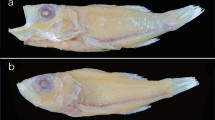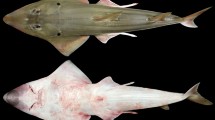Abstract
A rare Australian bothid flounder.Asterorhombus bleekeri (Macleay), is redescribed from the holotype and ten additional specimens from the east coast of Qeensland, Gulf of Carpentaria and Rowly Shoal (Western Australia). The species is transferred fromArnoglossus Bleeker toAsterorhombus Tanaka because of the lack of obvious sexual dimorphism in the interorbital width and pectoral fin length, the lack of rostral and orbital spines, the yellow-white blind side body coloration, and the deeply cleft parhypural and hypural plates. The definition ofAsterorhombus was emended as follows: the first dorsal fin ray continuous with or separated from remaining fin rays and gill rakers slender or stubby, with or without serrations.Asterorhombus osculus sp. nov., formerly briefly described in the literature as unidentified species ofEngyprosopon, was described from eight specimens from the northwestern coast of Australia. The new species is most similar toA. bleekeri in lacking sexual dimorphism, and having the caudal skeleton with deep clefts, two or three rows of teeth on the upper jaw and a pair of conspicuous black spots on the caudal fin, in addition to a similar general appearance, but is distinguished from the latter by shorter gill rakers, a very small mouth and feebly ctenoid scales on the ocular side. Both species clearly differed fromA. intermedius andA. fijiensis in having two (or three) rows of teeth on the upper jaws, slender gill rakers without serrations, first dorsal fin ray continuous with the other fin rays, and a pair of conspicuous black spots on the caudal fin.
Similar content being viewed by others
Literature Cited
Amaoka, K. 1963. A revision of the flatfishes referable to the genusEngyprosopon found in the waters around Japan. Bull. Misaki Mar. Biol. Inst., Kyoto Univ., (4): 107–121.
Amaoka, K. 1969. Studies on the sinistral flounders found in the waters around Japan. Taxonomy, anatomy and phylogeny. J. Shimonoseki Univ. Fish., 18: 65–340.
Amaoka, K., E. Mihara and J. Rivaton. 1993. Pisces, Pleuronectiformes: Flatfishes from the waters around New Caledonia.—A revision of the genusEngyprosopon. Pages 377–426in A. Crosnier, ed. Résultats des Campagnes MUSORSTOM, Volume 11. Mém. Mus. natn. Hist. nat., Paris, 158.
Amaoka, K., H. Senou and A. Ono. 1994. Record of the bothid flounderAsterorhombus fijiensis from the western Pacific, with observations on the use of the first dorsal-fin ray as a lure. Japan. J. Ichthyol., 41: 23–28.
Bleeker, P. 1866. Description de quelques espèces inédites des genresPseudorhombus etPlatophrys de l'Inde archipélagique. Ned. Tijdschr. Dierk., III: 43–50.
Gloerfelt-Tarp, T. and P. J. Kailola. 1984. Trawled fishes of southern Indonesia and northwestern Australia. Australian Development Assistance Bureau, Directorate General of Fisheries, Indonesia, and German Agency for Technical Cooperation, Canberra. xvi+406 pp.
Hubbs, C. L. 1915. Flounders and soles from Japan collected by the United States Bureau of Fisheries Steamer “Albatross” in 1906. Proc. U. S. Natl. Mus., 48: 449–496.
Leviton, A. E., R. H. Gibbs, Jr. E. Heal and C. E. Dawson. 1985. Standard symbolic codes for institutional resource collections in herpetology and ichthyology. Copeia 1985: 802–832.
Macleay, W. 1881. Descriptive catalogue of Australian fishes. J. Linn. Soc., London, 13: 121–139.
McCulloch, A. R. and G. P. Whitley. 1925. Some little known Australian flat-fishes. Rec. Aust. Mus., 14: 342–354, pl. 49.
Munro, T. S. R. (1957). Handbook of Australianfishes No. 16. Aust. Fish. Newsl., 16: 15–18.
Norman, J. R. 1926. A report on the flatfishes (Heterosomata) collected by the F.I.S. “Endeavour”, with, a synopsis of the flatfishes of Australia and revision of the subfamily Rhombosoleinae. Biol Res. Fishing Exped. F.I.S. Endeavour. 5: 219–308.
Norman, J. R. 1931. Notes on flatfishes (Heterosomata). I. Notes on flatfishes of the Bothidae in the British Muserum, with descriptions of three new species. Ann. Mag. Nat. Hist., Ser. 10, 8: 507–510.
Norman, J. R. 1934. A systematic monograph of the flatfishes (Heterosomata). 1. Psettodidae, Bothidae, Pleuronectidae. Brit. Mus., London. viii+459 pp.
Sainsbury, K. J., P. J. Kailola and G. G. Leyland. 1985. Continental shelf fishes of northern and north-western Australia, an illustrated guide. CSIRO, Div. Fish. Res., Canberra. viii+357 pp.
Temminck, C. J. and H. Schlegel. 1842–1847. Pisces. Siebold's fauna Japonica, supl. pl. A, Leiden. 323 pp.
Author information
Authors and Affiliations
About this article
Cite this article
Amaoka, K., Arai, M. Redescription of a rare bothid,Asterorhombus bleekeri (Macleay), and description of a new species ofAsterorhombus from northwestern Australia (Teleostei: Pleuronectiformes). Ichthyological Research 45, 249–257 (1998). https://doi.org/10.1007/BF02673923
Received:
Revised:
Accepted:
Issue Date:
DOI: https://doi.org/10.1007/BF02673923




